The Electronic Medical Records Market is estimated to be valued at USD 33.41 Bn in 2025 and is expected to reach USD 49.62 Bn by 2032, exhibiting a compound annual growth rate (CAGR) of 5.8% from 2025 to 2032.
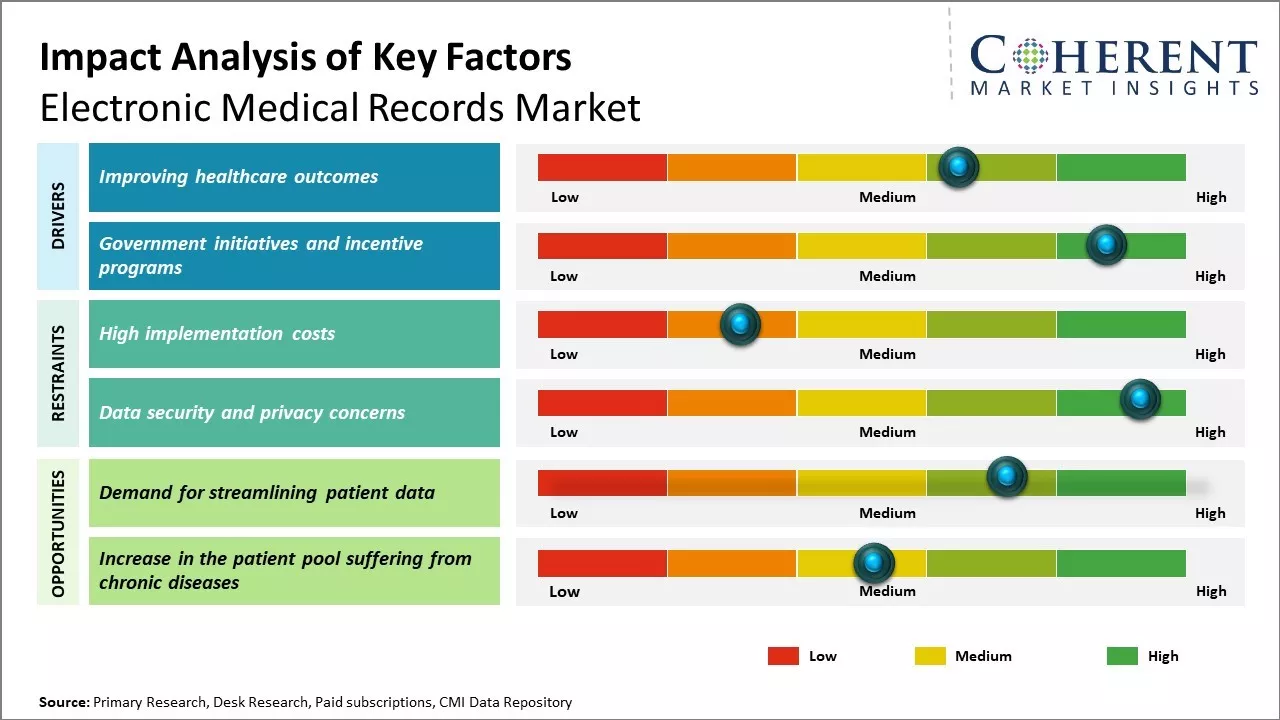
Discover market dynamics shaping the industry: Request sample copy
The adoption of electronic medical records has been steadily rising over the past decade. With government policies and initiatives promoting digitization of healthcare records, the demand for EMR systems from healthcare providers is expected to increase substantially. Integration of AI and analytics capabilities in EMR software is allowing providers to gain valuable insights which is supporting smarter clinical decision making. This is expected to drive further investments in upgrading existing EMR installation over the forecast period. Increased spending on healthcare globally due to growing disease burden and customer demand for easy access to medical records digitally will continue fueling the market expansion.
Improving healthcare outcomes
One of the primary drivers for increasing adoption of electronic medical records is the need for improving healthcare outcomes. With electronic medical records, a patient's complete medical history and health profile is easily available to doctors and healthcare providers. This helps in making accurate diagnosis and treatment plans. When doctors have access to comprehensive health records, they can gain deeper insights into a patient's conditions, previous treatments, allergies, lab results and more. This ensures continuity of care and avoids errors that may happen due to lack of critical health information. Electronic medical records also enable better management of chronic diseases. Doctors can closely monitor key indicators over long periods of time and make necessary modifications in treatment plans thus, driving the market development over the forecasted period.
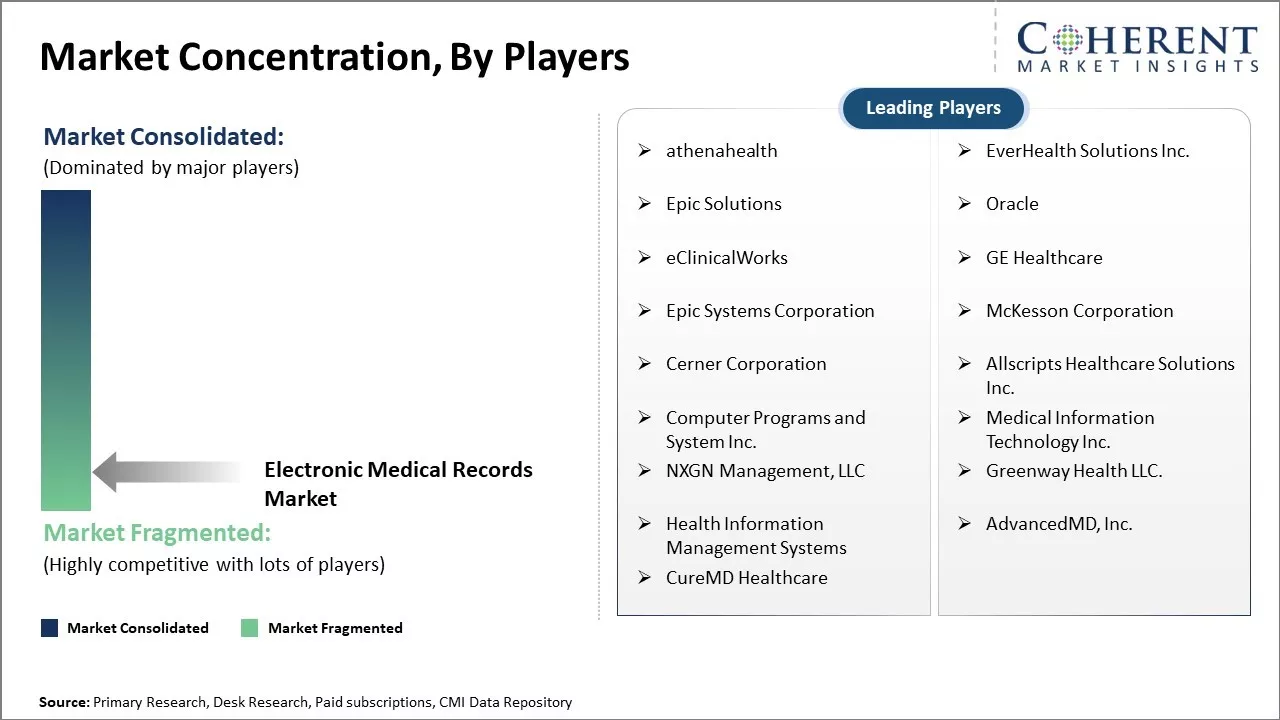
Get actionable strategies to beat competition: Request sample copy
Government initiatives and incentive programsAnother major driver has been the government policies and incentive programs encouraging nationwide adoption of electronic medical records. In many countries, governments have launched ambitious national eHealth programs where use of digital health records is being promoted across public as well as private healthcare facilities. This is helping in development of interoperable record systems supporting data exchange between different organizations. Some governments are even providing financial incentives to healthcare providers installing certified electronic medical records solutions. For example, in the U.S., the HITECH Act authorized the Centers for Medicare & Medical Services (CMS) EHR Incentive Programs which provided billions of dollars in incentives for hospitals and physicians adopting digital health records.
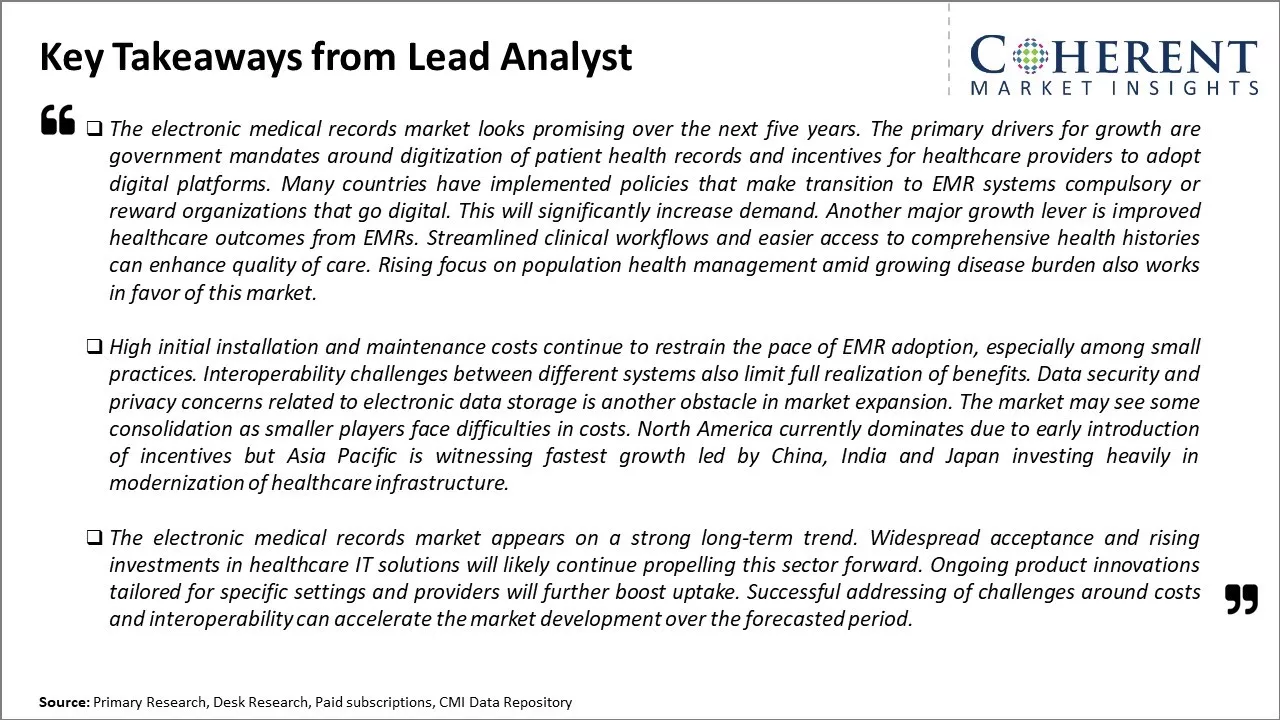
To learn more about this report, Request sample copy
Market Challenges: High implementation costsOne of the key challenges faced in the electronic medical records market is high implementation costs associated with investing in new technology systems and training staff to use them effectively. Data security is also a major concern as patient privacy needs to be protected. There is resistance to change from some doctors and medical practices who prefer using paper records. Ensuring data is transferred accurately between different systems used by healthcare providers remains an issue. Standardization across the industry has been difficult to achieve as well.
Market Opportunities: Demand for streamlining patient data
As healthcare moves increasingly online, the demand for digitizing records will only rise in the coming years. Streamlining record sharing between providers can improve treatment coordination and patient outcomes. Analytics of aggregated medical data can facilitate medical research discoveries. Adoption of electronic prescribing can help reduce errors. With ongoing tech advances, costs are expected to continue declining over time.
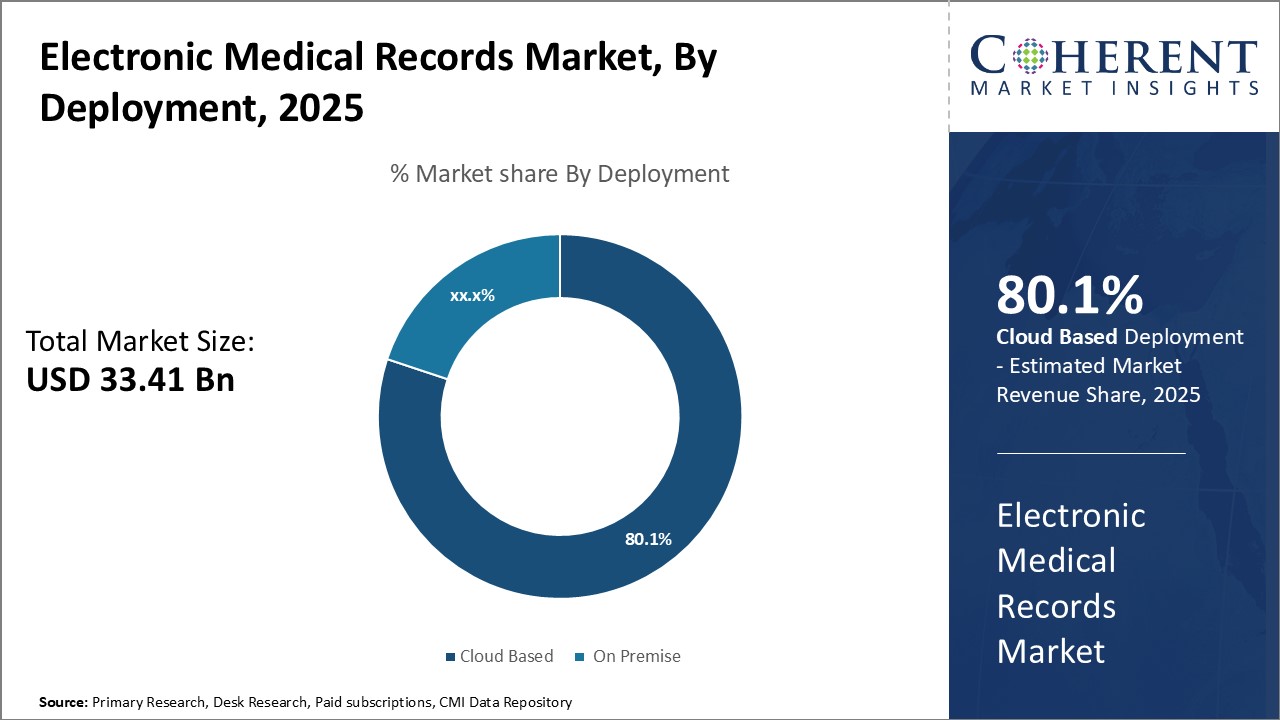
Discover high revenue pocket segments and roadmap to it: Request sample copy
Insights, By Deployment: Rising Adoption of Cloud-Based Solutions Driving Growth of the Cloud Based SegmentThe deployment segment includes cloud based and on premise. Cloud based segment is estimated to hold 80.1% of the market share in 2025. Healthcare organizations are under constant pressure to reduce costs while improving patient care services. Cloud based EMR solutions help address this challenge as they eliminate the need for upfront capital investment on hardware and infrastructure and shift costs to operational expenditure. This provides flexibility in budgeting and faster return on investment. Cloud platforms also enable seamless access to patient records from any internet enabled device. Physicians and healthcare staff can securely access patient files on their mobile devices and laptops while on field. This improves workforce productivity and facilitates delivery of care beyond traditional facilities. The scalability of cloud models allows providers to adapt storage and computing resources as per changing needs.
Insights, By Application: Medical History Segment Dominates due to Importance in Clinical Decision Making
The application segment includes medical history, laboratory test results, radiology images, surgical records, and others. Medical history contributes the highest share of the electronic medical records market and is estimated to hold 34.3% of the market share in 2024. Detailed and well-documented patient history plays a crucial role in clinical decision making and delivering right diagnosis and treatment. It provides a longitudinal view of the patient’s health status over time, past medical interventions, family history, social habits and much more. This aids physicians in identifying underlying conditions, examining disease progression and predicting health outcomes. Compiling and maintaining comprehensive medical histories is time consuming for healthcare staff. EMR systems automate this process by facilitating easy entry of history at each patient encounter thus, driving the segment growth over the forecast period.
Insights, By End User: Hospitals Lead EMR Adoption due to Heavy Patient Volumes and Need for Coordinated Care
The end user segment includes hospitals, physicians’ clinics, ambulatory care centers, and others. Hospitals contributes the highest share of the electronic medical records market and is estimated to hold 42.1% of the market share in 2025. Hospitals manage heavy patient admittance on a daily basis and rely heavily on technology to streamline workflows and coordinate care across large staff. EMR systems help bring disparate paper-based records onto centralized digital platforms for easy access and sharing between departments and caregivers. Hospitals need to adhere to strict documentation and billing guidelines. EMRs automate charge capture at each patient encounter, facilitating compliant coding and billing. Digitizing records also helps address storage and archival challenges faced by hospitals due to voluminous paper records. Integrated EMRs connect various departments like registration, laboratory, pharmacy, radiology through a single network, eliminating duplication of efforts.
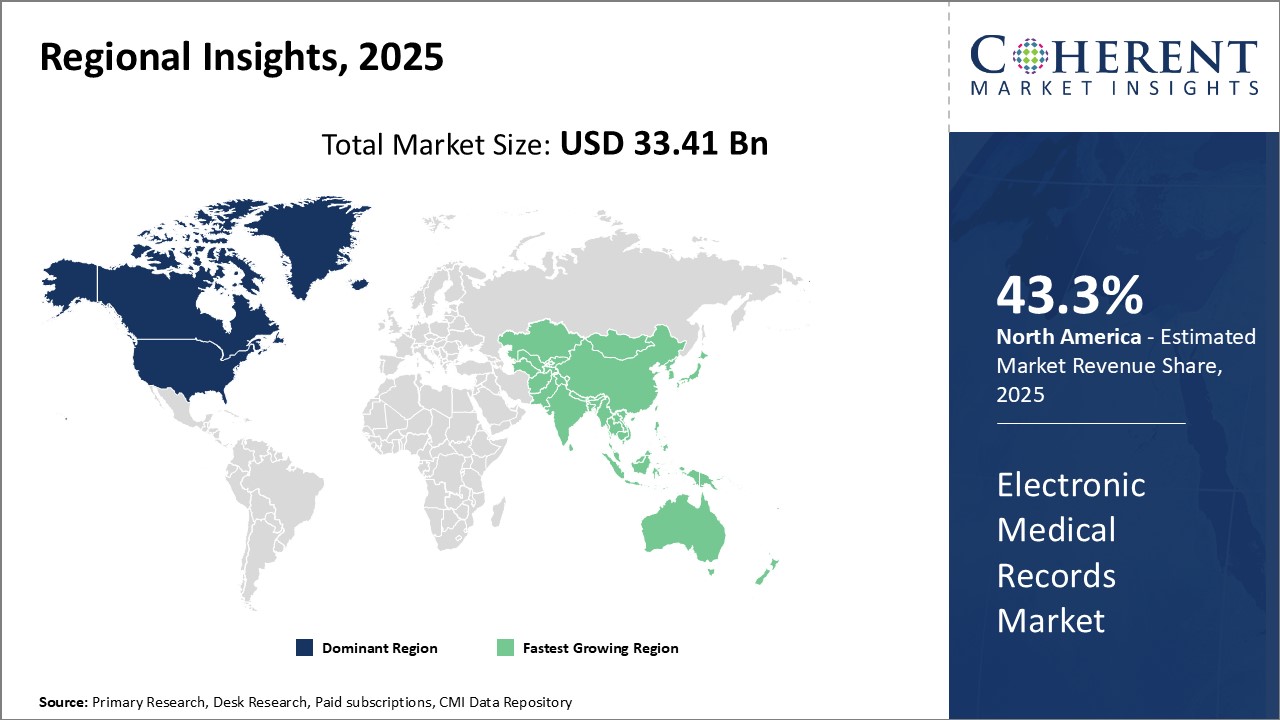
Need a Different Region or Segment? Customize now
North America has firmly established itself as the dominant regional market for electronic medical records (EMR) and is estimated to hold 43.3% of the market share in 2025. The early adoption of digitalization across the American healthcare sector provided local companies an advantage in developing EMR technologies. Several leading EMR software providers such as Epic Systems, Cerner and Allscripts gained their roots in the US market, perfecting their offerings to meet the specific needs of various healthcare providers from large hospitals to small physician practices. With over a decade of implementation experience, the US boasts high EMR usage rates of over 85.5% among eligible providers. The centralized push for digitalization through government incentives like Meaningful Use also ensured wide acceptance of EMR systems in the region. Many hospitals and physician offices now rely on these systems for clinical workflows and patient data management.
The Asia Pacific region presents the most promising growth prospects for EMR vendors looking beyond saturated Western markets. Countries like China, India, Japan, Australia and South Korea are experiencing exponentially rising healthcare demands with limited resources. This provides a strong impetus for EMR adoption that can enhance coordination, resource optimization and expand access in these nations. The region also possesses growing domestic capability in IT and internet where EMR platforms can be tailored. Several local and multinational companies have already established Asia Pacific headquarters to gain first-mover advantage as governments roll out electronic health plans. With rising income levels and its massive population base, the Asia Pacific region is primed to become the electronic medical records market of the future.
Electronic Medical Records Market Report Coverage
| Report Coverage | Details | ||
|---|---|---|---|
| Base Year: | 2024 | Market Size in 2025: | USD 33.41 Bn |
| Historical Data for: | 2020 To 2024 | Forecast Period: | 2025 To 2032 |
| Forecast Period 2025 to 2032 CAGR: | 5.8% | 2032 Value Projection: | USD 49.62 Bn |
| Geographies covered: |
|
||
| Segments covered: |
|
||
| Companies covered: |
athenahealth, EverHealth Solutions Inc., Epic Solutions, Oracle, eClinicalWorks, GE Healthcare, Epic Systems Corporation, McKesson Corporation, Cerner Corporation, Allscripts Healthcare Solutions Inc., Computer Programs and System Inc., Medical Information Technology Inc., NXGN Management, LLC, Greenway Health LLC., Health Information Management Systems, AdvancedMD, Inc., and CureMD Healthcare |
||
| Growth Drivers: |
|
||
| Restraints & Challenges: |
|
||
Uncover macros and micros vetted on 75+ parameters: Get instant access to report
*Definition: The Electronic Medical Records Market involves products and services related to digitizing patients' medical records and making them available electronically. This includes electronic health record software, medical document management solutions, computerized physician order entry systems, and other digital tools and platforms that allow healthcare providers to maintain, update and access patients' comprehensive medical history, diagnosis, medications, treatment plans, immunization dates, allergies, radiology images and laboratory test results through a secure records system.
Share
Share
About Author
Manisha Vibhute is a consultant with over 5 years of experience in market research and consulting. With a strong understanding of market dynamics, Manisha assists clients in developing effective market access strategies. She helps medical device companies navigate pricing, reimbursement, and regulatory pathways to ensure successful product launches.
Missing comfort of reading report in your local language? Find your preferred language :
Transform your Strategy with Exclusive Trending Reports :
Frequently Asked Questions
Joining thousands of companies around the world committed to making the Excellent Business Solutions.
View All Our Clients
US Reciprocal Tax Impact Analysis On Electronic Medical Records Market
Stay updated on tariff changes with expert insights and timely information